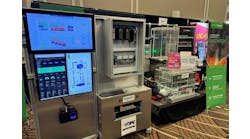The COVID-19 pandemic is probably the greatest test of resilience the automation market has ever faced. It's changed how and where companies spend their money and the fundamental nature of work in the manufacturing sector, and many of these changes will last long after the pandemic subsides. We knew 2020 was going to be a challenging year when we wrote this article last year, but the Top 50 global and North American automation suppliers faced up to the challenges of COVID-19 by quickly adapting to changing market dynamics and capitalizing on new technologies that help end users become more resilient.
The primary enabler behind this improved resilience is digitalization. The Top 50 suppliers continue to expand their offerings for Industrial Internet of Things (IIoT) computing, cloud computing, virtualization, containerization and the entire suite of technologies that fall under the IIoT umbrella. At ARC, we've always promoted the idea that technology shouldn't be embraced for its own sake, but rather as an enabler for achieving operational excellence and improving returns on investment and assets. Many end users saw COVID-19 as the catalyst for creation acceleration and implementing digitalization efforts because there was simply no other way for them to adapt to the many challenges posed by the pandemic.
Digitalization cures vulnerable supply chains
The toilet paper shortage during COVID-19 is an easy and relatable example of the value of digitalization to manufacturers and consumers. The pandemic resulted in many empty offices and facilities, which resulted in a drop in demand for institutional paper and sharp rise in demand for residential paper. All discussion of hoarding aside, the paper producers largely couldn’t keep up with demand because the entire supply chain from raw materials to final distribution wasn’t agile enough. It’s no accident that many leading digital transformation programs recently put into place are at some of the world’s leading paper manufacturers.
Digital transformation directly affects agility, product quality, uptime and more. Opportunities and challenges arise quickly, and participants have to adapt and capitalize on them just as quickly and effectively. This is the ultimate promise of digitalization and the definition of resilience.
If it seems like everything is happening at once, it is. The challenges aren't over yet, as the more recent surge in COVID-19's Delta variant shows us. Other challenges loom, many of which are outgrowths of the pandemic. The supply chain has become particularly vulnerable. The silicon shortage has created numerous challenges for just about everybody in manufacturing. Cyber-attacks have shut down ports, assembly lines and water treatment plants. The increasing pace of climate change and changing nature of the hydrocarbons industry are creating renewed momentum for renewable energy, and resulting in the “mass electrification” of many applications and technologies that previously relied on more hydrocarbon-based sources of power. Reimplementation of lockdowns changes consumer demand quickly.
COVID-19’s impact on the workforce is also accelerating adoption of many new technologies we mentioned last year. End users are on a path to autonomous operations, and the drive to improve the safety of work environments is resulting in changes in everything from control room design to shift management and the cybersecurity of remote workers. Remote work isn’t just for cubicle farms anymore. More operations personnel are performing their duties offsite, so access to sensitive plant and production information must be done remotely and securely. End users are escalating the use of remote access to reduce field visits, enable remote personnel, and provide remote troubleshooting and training.
Challenging traditional suppliers
The Top 50 suppliers have done an admirable job of addressing the challenges brought on by COVID-19. Keep in mind that the suppliers themselves were already on a path to digitalization when the pandemic struck. Probably their biggest challenge was articulating the value proposition of digitalization to their customers, but COVID-19 provided ample impetus for customers to adopt IoT technologies and speed up their digitalization programs. While the automation suppliers of the world may start to look more like Google, Amazon Web Services (AWS) or Microsoft, don’t expect the latter to replace the former any time soon. The automation suppliers continue to take the new technologies offered by the IT suppliers, and put together solutions that are tailored for specific manufacturing applications. Plus, they still have plenty of their own technology and service expertise to offer.
End users are also using digitalization and digital transformation to gain insight and visibility into supplier performance, inventories and other metrics.
The application-specific nature of the engineered systems in manufacturing applications, and their extreme real-time, mission-critical nature will always be the distinguishing factor for the world of operations technology (OT). The deep expertise in these unique applications will continue to be a key differentiator for automation suppliers, regardless of which new technology they use. If you don’t understand the problems faced by OT, you can’t use information technology (IT) as a magic wand to create solutions. This is why we don’t see major changes in the list of suppliers year after year—nobody has stepped in to successfully challenge them.
Companies like Google and Microsoft are also referred to as "hyperscalers" because they can offer cloud, networking and Internet services on massive scales. While the hyperscalers probably won’t replace the leading automation suppliers in the near future, hyperscalers are responding to the importance of the IIoT edge in fulfilling their value proposition by extending their reach into lower tiers of the architecture. Hyperscalers are extending their reach, not only in search of data, but also in pursuit of executing analytics, artificial intelligence/machine learning (AI/ML), augmented reality/virtual reality (AR/VR) and similar applications at the edge. Microsoft Azure IoT Edge, AWS Greengrass, and Google Cloud IoT Edge represent just some of the edge initiatives by enterprise cloud providers. Concurrent with the descent of the hyperscalers is the adoption of cloud-native and open-source technologies that offer numerous advantages in design, management and scalability. Numerous industry activities are pursuing specific aspects of IIoT, ranging from the Industrial Internet Consortium's (IIC) testbeds to open-source efforts such as Eclipse, EdgeX Foundry and LF Edge.
Plenty of end users still want to solve their own problems, and are looking at these new technologies as enablers for easier development of their own solutions. They're developing and deploying digital twins, high-fidelity simulations and more advanced cybersecurity organizations, and demanding more open and modular systems that are immune from the development cycles of the large suppliers, such as the new specifications offered by the Open Process Automation Forum (OPAF).
Automation and its associated work processes, from engineering and design to operations and maintenance, also remain burdened by needless complexity. Again, digitalization is providing solutions in the form of better integration between engineering and process automation applications, late-binding concepts, virtualization and containers, and software-defined networking. Technologies like procedural automation and bulk automation of manual tasks are increasingly being deployed to free up remaining personnel to focus on value-added tasks.
Top 50 N. American Automation Vendors
2020 N. American revenue (US$ millions)1
Top 50 Global Automation Vendors2020 Worldwide Revenue (US$ millions) |
||
| 1 | Siemens | $12,025 |
| 2 | ABB | $11,175 |
| 3 | Emerson | $10,995 |
| 4 | Schneider Electric | $6,636 |
| 5 | $6,211 | |
| 6 | $3,773 | |
| 7 | $3,587 | |
| 8 | Mitsubishi Electric | $3,304 |
| 9 | $3,257 | |
| 10 | Festo | $3,241 |
| 11 | Omron |
$3,211 |
| 12 | Endress+Hauser | $2,941 |
| 13 | Ametek EIG | $2,925 |
| 14 | Phoenix Contact | $2,739 |
| 15 | $1,961 | |
| 16 | Sick AG | $1,940 |
| 17 | MKS Instruments | $1,900 |
| 18 | Advantech | $1,755 |
| 19 | Spectris | $1,724 |
| 20 | GE | $1,466 |
| 21 | Baker Hughes | $1,336 |
| 22 | National Instruments | $1,287 |
| 23 | TechnipFMC |
$1,286 |
| 24 | Roper Technologies | $1,254 |
| 25 | Fanuc | $1,233 |
| 26 | $1,225 | |
| 27 | Wika |
$1,170 |
| 28 | IFM | $1,142 |
| 29 | $1,120 | |
| 30 | Teledyne Instruments | $1,095 |
| 31 | Aveva |
$1,058 |
| 32 | Flowserve | $1,058 |
| 33 | Yaskawa | $1,052 |
| 34 | $1,047 | |
| 35 | $1,031 | |
| 36 | $947 | |
| 37 | $904 | |
| 38 | $866 | |
| 39 | $856 | |
| 40 | $836 | |
| 41 | Hitachi |
$810 |
| 42 | $759 | |
| 43 | $758 | |
| 44 | $751 | |
| 45 | Bosch Rexroth | $745 |
| 46 | Pepperl+Fuchs | $742 |
| 47 | $689 | |
| 48 | $658 | |
| 49 | $657 | |
| 50 | $638 | |
| Total | $115,767 | |
Coming out of the COVID-19 recession
The worldwide and North American automation markets almost universally declined in 2020 due to COVID-19. By April 2020, more than 80% of flights were restricted, cargo capacity was down, airlines and rental car companies reduced their fleets, and West Texas Intermediate Crude hit less than $37 per barrel. Consolidated revenues for the Top 26 automation suppliers tracked by ARC contracted by over $8 billion between 2019 and 2020. But, as we’ve already mentioned, the suppliers themselves became more agile, and the market is already making a substantial recovery into the first half of 2021.
Among other things we do at ARC, we track the quarterly revenue growth of automation suppliers that publicly report their results. While we can’t present those results to you here, we can tell you that the automation market rose by 17% in the first quarter of 2021. Almost all automation companies recovered or saw good growth in mid to high single-digit ranges in the first quarter. In 2Q21, almost all the automation companies continued on their recovery path, with some experiencing double-digit growth rates. Constant demand for automation products has helped the market grow at a much faster pace compared with 1Q21. Many of the recent supplier results show extremely strong growth in orders, but this doesn’t immediately translate to increased shipments and revenues, and we should expect constrained growth in revenues vs. orders moving forward.
Chip shortage burdens manufacturers
Despite promises of capacity expansion and new projects, the microprocessor chip shortage continues unabated, and according to many sources it’s getting worse. The impact of COVID-19 rippled through the silicon supply chain just as it did other industries. As the automotive industry was making a V-shaped recovery in the summer of 2020, the chip shortage was looming just a few months in the future, and it hasn’t gone away. While automotive is facing the brunt of the shortage with projected chip-related losses at $210 billion in 2021, it’s also hit the market for PCs, smartphones, GPUs, consumer electronics, smartphones and just about anything that requires a chip, including automation products and systems.
Again, the sensitivity and complexity of supply chains are a major force behind this shortage. According to semicondcutor.org, there are 50 points across the semiconductor value chain where one region holds more than 65% global market share. All of these points on the supply chain are single points of failure, which could easily be disrupted by natural disasters, pandemic shutdowns or other events.
For machine as well as automation companies, this is an extremely tough situation because their market power is often smaller compared to large automotive and consumer electronics manufacturers. The challenge for industrial users is the often-small batch sizes of semiconductors ordered because OEMs and automation vendors often have small unit numbers shipped. On the other hand, smaller batch sizes and the less just-in-time nature of the value chain also enable OEMs and automation companies to be more flexible.
Still, according to the German engineering association, VDMA, selected OEMs weren't able to deliver machinery due to the chip shortage. Looking at market shares, we'd expect that the larger the company, the more it can use its purchasing power to overcome the shortage.
In early 2021, a spokesman from the automotive industry estimated the chip shortage will be gone by the second half of the year. At present, it's still ongoing, and looking back to 2020, we can ask ourselves if investments in a more diversified and adaptable value chain will come. For example, Bosch invested in a large semiconductor factory in Dresden, Germany. The current outlook is that the shortage will last through 2021, and will most likely follow us into 2022. Many of the suppliers we speak to expect the shortage to continue through the end of 2022, given the current average 58-week lead time for all types of components like ASICs, CPUs and even metal. Intel corroborates this, warning that the worst is yet to come in the second half of 2021, and temporary shortages may remain for one to two years.
Semiconductor production is complicated and requires significant capital expenditures. This means it will take time, and many semiconductor companies will think twice before taking the money to ramp up capacity. After all, they operate in a market full of natural monopolies and higher prices mean higher margins.
Open Process Automation
The Open Process Automation Standard (O-PAS) continues to move forward with its vision of a standards-based, open, secure and interoperable process control architecture, which lets end users preserve their existing investments, while simultaneously enabling them to move forward with new investments in technologies and applications. A significant milestone was achieved in May of this year, when Version 2.1 of the O-PAS standard was published. Where possible and applicable, O-PAS embraces existing industry standards for industrial automation systems. These documents are publicly available on the OpenGroup's website for the Open Process Automation Forum, where industry feedback on O-PAS is encouraged.
Another key event in terms of testing the utility of this standard is the Interoperability Workshop (PlugFest) planned for later in 2021. Currently, O-PAS Version 3 is being drafted and the themes are: application portability (Part 8), distributed control node (DCN) physical platform (Part 7), and orchestration, which OPAF members sometimes call “systemness.”
ARC Advisory Group's analysts and Control's editors discover new firms to add to the Top 50 lists each year. If you find one that should be listed but isn't, let us know, so it can be evaluated for potential inclusion. Though companies with increased sales are added and those with decreased sales relative to the others or those that have been acquired are removed, the Top 50's basic analysis methodology hasn't changed for years. If anything, it's scope and focus on revenue generated by process control and automation activities have grown tighter.
Technologies included in the Top 50 definition:
- Process automation systems and related hardware software and services;
- PLC and related hardware, software, services, I/O and bundled HMI;
- Other control hardware components, such as third-party I/O, signal conditioners, intrinsic safety barriers, networking hardware, unit controllers, and single- and multi-loop controllers;
- Process safety systems;
- SCADA systems for oil and gas, water and wastewater, and power distribution;
- AC drives;
- Motion control systems;
- Computer numerical control (CNC) systems;
- Process field instrumentation, such as temperature and pressure transmitters, flowmeters, level transmitters and associated switches;
- Analytical equipment, including process electrochemical, all types of infrared technology, gas chromatographs for industrial manufacturing and related products;
- Control valves, actuators and positioners;
- Discrete sensors and actuators;
- All kinds of automation-related software from advanced process control, simulation and optimization to third-party HMI, plant asset management, production management (MES), ERP integration packages from the major automation suppliers and similar software, and other automation-related services provided by automation suppliers;
- Condition-monitoring equipment and systems; and
- Ancillary systems, such as burner management systems, quality control systems for pulp and paper, etc.
Technologies not included in the Top 50 definition:
- Pumps and motors
- Robotics
- Material-handling systems
- Supply chain management software
- Building automation systems
- Fire and security systems
- Processing equipment such as mixers, vessels, heaters, as well as process design licenses from suppliers that have engineering divisions
- Electrical equipment, such as low-voltage switchgear, etc.
Business ecosystem building in OPAF
The Business Working Group within OPAF focuses on building a business ecosystem using the standard. The first version of the OPA Business Guide was published in 2019, and the team is working on Version 2.0. This guide provides valuable information about business scenarios across various industry verticals, stakeholder roles in the O-PAS ecosystem, conformance, certification and contracting processes. OPAF is working with other standards organizations and industry associations, such as the OPC Foundation, NAMUR, CSIA, ISA, etc. O-PAS already has a certification policy process that was published in February 2020. OPAF is also in discussions with multiple O-PAS verification labs, and the first wave of the certification process is expected to become operational in the first quarter of 2022.
Increasing importance of cybersecurity
OT cybersecurity strategies with basic, passive defenses may have been enough for yesterday’s basic malware attacks, but they can’t protect companies against today’s threats.
OT systems also need advanced defenses to protect systems from sophisticated attacks, like the recent Triton and SolarWinds incidents. Such attacks may target specific operations to achieve political and espionage goals. These attackers have the resources and funds to research companies fully, identify exploitable security weaknesses, penetrate defenses with a variety of surreptitious techniques (spear phishing, supply chain downloads, etc.), and develop complex malware to accomplish their goals.
Ransomware attacks on industrial companies, such as the one that disrupted Colonial Pipeline’s operations, are increasing at a frightening pace. One recent research report noted that almost one-third are launched against industrial companies because cyber-criminals recognize that the incredible costs of downtime can encourage ransom payments.
Organizations that provide critical infrastructure, like power, water and transportation, also face external pressures to rapidly restore operations. While the focus of many of these attacks has been limited to IT, there's every reason to expect eventual movement into connected OT systems. Thriving cyber black markets will also increase the number of such attacks and raise the risks for industrial companies. In this environment, cybersecurity is no longer an afterthought.
Consequently, virtually all suppliers are increasing their investments in their own cybersecurity solutions, investing in or acquiring OT-level cybersecurity suppliers, and strengthening their partnerships. There's still plenty of room for consolidation in the realm of OT level cybersecurity suppliers, which number in the hundreds. Many of these suppliers will make attractive acquisition targets for the automation suppliers in the future. With the increasing adoption of IIoT, cybersecurity technologies and approaches from the IT world are also being adopted at the OT level. Many of the more IT-centric cybersecurity suppliers are strengthening and expanding their offerings for OT applications.
About the authors
Larry O'Brien, VP of research; Allen Avery, automation research analyst; Florian Güldner, research director; Chantal Polsonetti, VP of advisory services; and Sharada Prahladrao, editor and PR manager, are all of ARC Advisory Group, and can be reached via Larry at [email protected]




